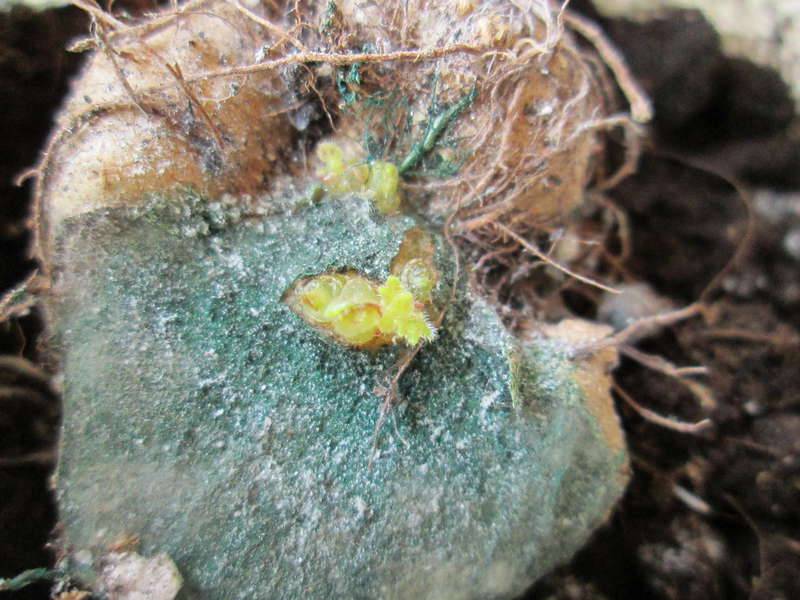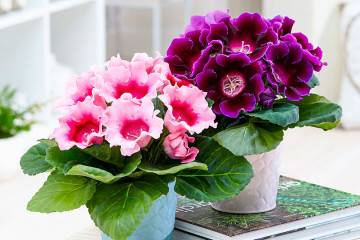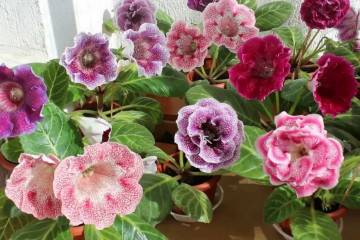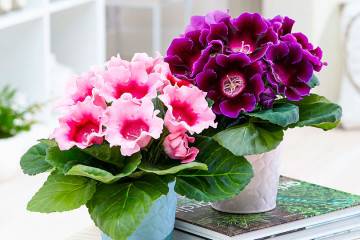Gloxinia has faded - what to do next, how to care
Content:
Gloxinia fell in love with many flower growers because of its beautiful and lush flowering, from which it is impossible to take your eyes off. But, unfortunately, the plant does not bloom all year, and after flowering something needs to be done so that the flower in the future will also abundantly please the eye with its gramophones.
Gloxinia flowering period at home
The flowering period of gloxinia at home is very long. It is conventionally divided into two stages. The first runs from March to June. The second stage lasts from July to October. But the timing may vary depending on the correct care and climate in the growing region. With proper care, flowering can last until November. It is necessary to create ideal conditions, and then the flowering will be not only long-term, but also abundant.
During the flowering period, it is necessary to provide the culture with the most favorable conditions:
- first of all, the flower must be protected from direct sunlight, which adversely affects the foliage;
- it is also important to maintain a high level of humidity within 70-80%;
- watering should be regular and moderate;
- overdrying of the soil should not be allowed;
- you can irrigate the soil after the topsoil dries up.
How to prolong flowering
Many growers are interested in extending the flowering of gloxinia for a longer period. This can be done with the right crop care.
How to make gloxinia bloom for as long as possible:
- install additional lighting next to the pot. You need to turn it on when daylight hours decrease;
- faded inflorescences and foliage must be cut off immediately. After pruning, you need to leave hemp up to 1 cm high. After a while, new shoots will appear from the tubers. Leave only 1-2 sprouts of them. After a while, a rosette of leaves will grow of them, and gloxinia will bloom for the second time in a season. During pruning, it is worth removing the top layer of soil and filling in a new one;
- the flower belongs to the thermophilic, therefore the air temperature should be from 18 ° C to 22 ° C. A sharp drop in temperature negatively affects the culture;
- abundant watering and provide high air humidity.
An important point is the introduction of top dressing. They begin to be added to the soil in early April. Finish fertilizing the soil in August. Fertilizers are applied every week.
What to do with faded gloxinia flowers
What to do next if the gloxinia faded in June:
- if the plant has bloomed in the summer, then you need to cut the peduncles at the root;
- you need to cut off with a sterile sector or with a knife, so as not to infect.
If the stem with the inflorescence was short, a few leaves should be left on it. In the future, stepchildren will grow from the sinuses. Of these, you will then need to leave 2-3 strong shoots, cut off the rest.
How to care for gloxinia after flowering
Many gardeners are interested in whether gloxinia has faded - what to do next, how to prepare a flower for a dormant period. In order for the plant to grow healthy and bloom profusely all year round, you need to take care of the flower after flowering. Care at this stage is aimed at preparing gloxinia for wintering.
Pruning
Immediately after the inflorescences have faded, they must be cut off. You cannot remove the foliage, you need to wait until the moment when it dries itself. During this period, the flower prepares for wintering and accumulates strength in the tubers. It lasts until mid-October. When all the foliage is dry, it must be carefully cut off, leaving a part of the stems 1-2 cm long above the tuber.
After trimming the hemp, you need to water for another 2-3 weeks.
What to do with faded inflorescences:
- after the inflorescences have faded, it is not necessary to wait until they wither;
- you can, as the buds fade, cut the peduncles;
- the stems must be cut off with a sharp processed tool;
- faded inflorescences must be thrown away.
If the flower bloomed again in November, you need to let it bloom and only then start preparing for winter. The first thing to do is to cut back on watering.
Restorative feeding
Caring for gloxinia after flowering at home means feeding. The last time the flower is fed is closer to autumn. The fertilizer should not contain nitrogen. For example, potassium monophosphate is great. Then fertilization cannot be applied until the flower awakens in spring.
Preparing the plant for hibernation
Preparation for wintering a flower concerns primarily the choice of a method for storing tubers. The second point is the termination of watering and fertilization. Otherwise, there are no essential procedures for preparing tubers for wintering.
Gloxinia after flowering: what to do, where and how to store tubers
There are two methods to keep the tubers intact during the winter.
During the storage period, there is a risk of developing fungal or any other diseases. It is improper storage that most often becomes the cause of the appearance of diseases. A sharp and frequent change in temperature, dampness lead to problems with gloxinia in the future.
Pot
After the flower has bloomed, it can winter at home. In this case, the tubers are left in the pot.
What to do when gloxinia fades and how to store tubers in a pot:
- moisten the soil with a little water around the edges of the pot. Abundant watering is fraught with rotting roots and the appearance of mold, so it is better not to overdo it with it;
- sprinkle containers with tubers with sand, cover them with a pallet and wrap them in a plastic bag;
- then the containers need to be rearranged in a dark, cool place;
- the main thing is that the room in which the planting material is located is not damp, otherwise all tubers will be covered with mold and they can be thrown away.
Gloxinia tubers need to be watered regularly with a little water. As a rule, by the end of January - beginning of February, the first shoots begin to appear from the planting material. This is the first signal that the flower needs to be taken into the house and transplanted into a new soil.
This method is most preferable for young gloxinia tubers, which retire for the first time.
Package
The second storage method is in a package.
Step-by-step process of storing gloxinia tubers in a package:
- Gently remove the gloxinia tubers from the pot, clean the earthen ball with your hands, then rinse them under a weak stream of water.
- The main thing during washing is not to damage the tubers.
- Spread the washed planting material on a towel to dry.
- When the tubers are dry, you need to carefully examine them. Weak and thin roots are cut off.
- For storage, it is better to take not an ordinary plastic bag, but a bag with a zip-lock fastener.
- Pour a few tablespoons of peat into the bag, the same amount of vermiculite and add a few tablespoons of water.
- Stir the soil until smooth.
- Then place the tubers in it, shake the bag so that the roots are in the ground.
- Close the bag so that there is no air in it.
If during the inspection it turned out that mold has nevertheless appeared on the planting material, you need to immediately take measures before it is too late.
What to do if the tubers become moldy:
- Remove the planting material from the bag.
- Trim the damaged area.
- Sprinkle the cut with crushed charcoal.
- Spread the tubers in the open air and dry them.
- Then put it back in the bag.
In this case, it is better to throw out the old soil and make a new one. If you re-fill the planting material with the old substrate, there is a high probability that the mold will reappear.
This method of storing planting material is used most often. It is suitable for adult plants, which are sent for a dormant period for several years.
Gloxinia after flowering needs special care and rest. This is necessary so that the flower gains strength over the winter and begins to bloom as quickly and abundantly as possible in the spring. When storing gloxinia tubers, a number of nuances must be taken into account so that they do not die or become infected with any diseases.




















